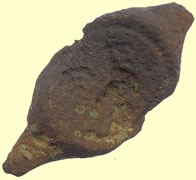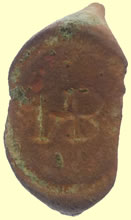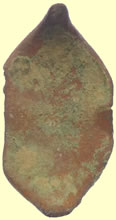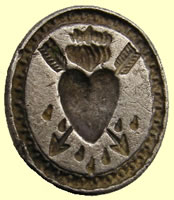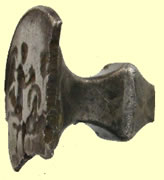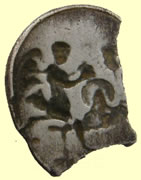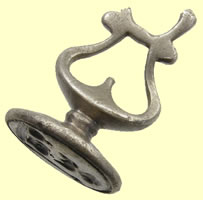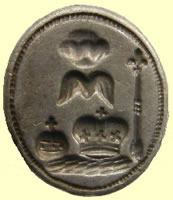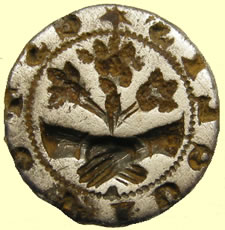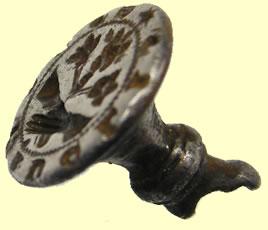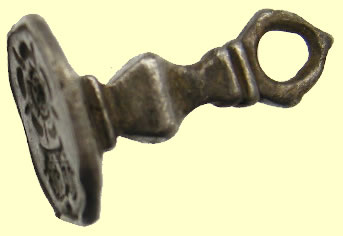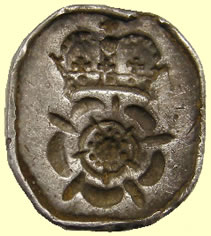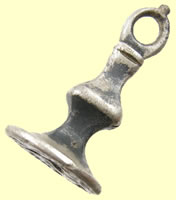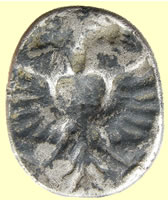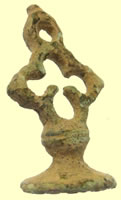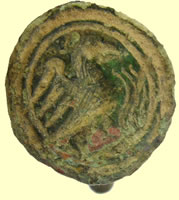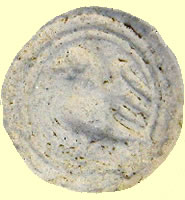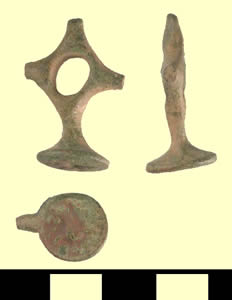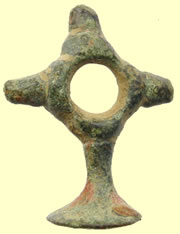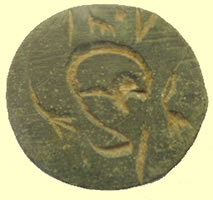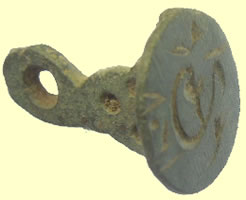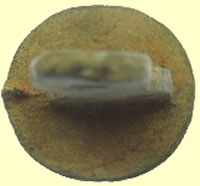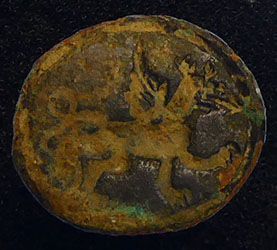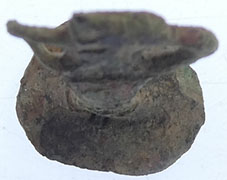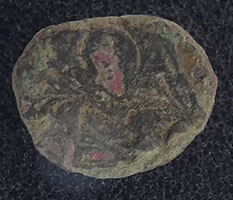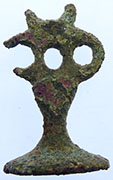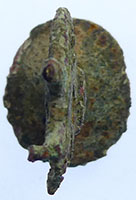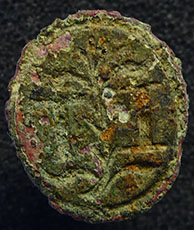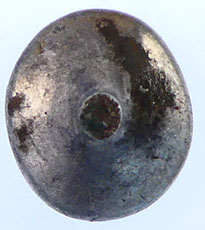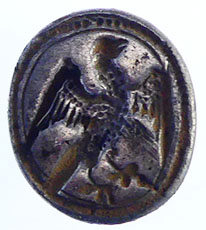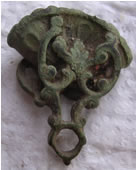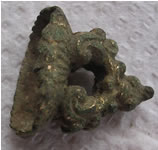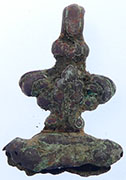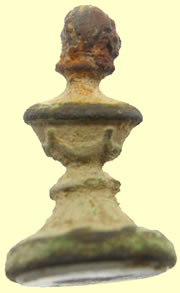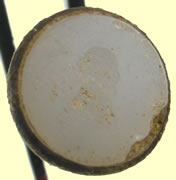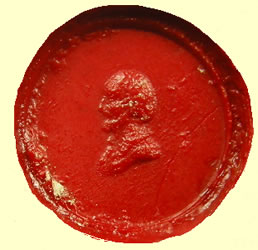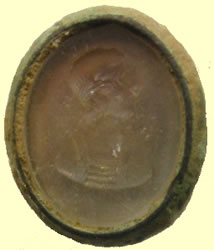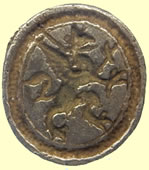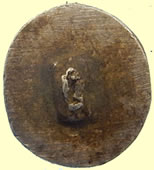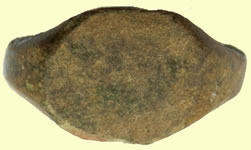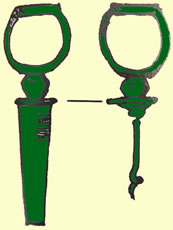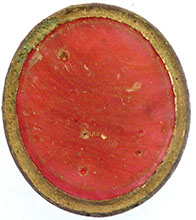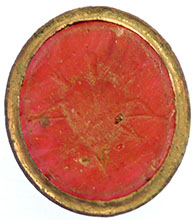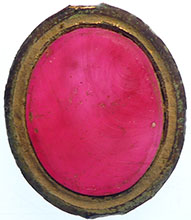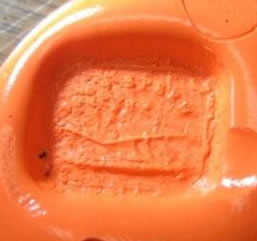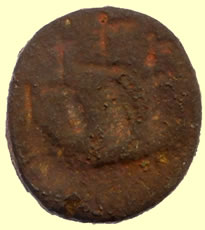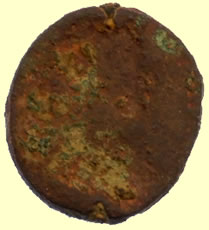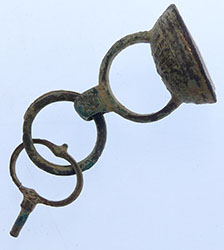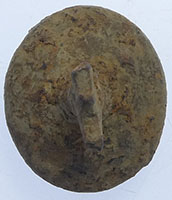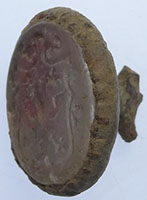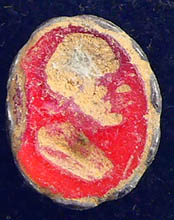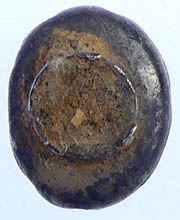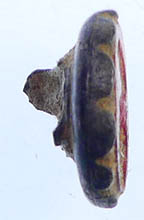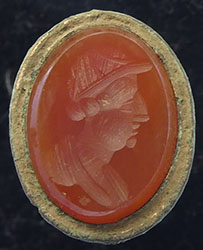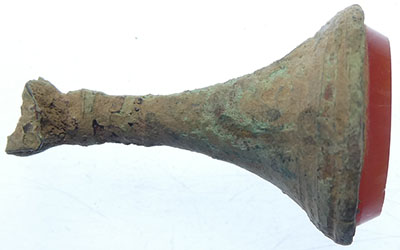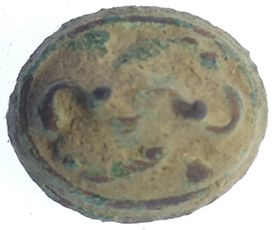

Metal detecting holidays in England with the World's most successful metal detecting club.
Twinned with Midwest Historical Research Society USA
Seal Types
Prior to the fifteenth century pointed oval designs, called vesica seals, were popular with noble women and also with high ranking ecclesiastics. The shape allowed room either to depict a full length standing figure of the owner, or alternatively to show scenes at two levels. Monastic seals often used the latter device, with a main, upper register depicting the monastery’s patron saint, and a small lower register in which the prior or abbot was shown praying. By the fifteenth century, vesica seals were somewhat out of fashion, but they still occur on documents, because monasteries in particular tended to continue using seal matrices made years — or sometimes centuries — earlier. By the fifteenth century, use of seals was widespread. One nobleman is said to have remarked acidly that in earlier times it had not been the custom for every Tom, Dick and Harry to use a seal. Most seals were quite small, and the most common forms of matrix were the pyramid seal (a small, usually circular design with a stem on the back, by which it could be held) and the signet, which could be of any shape (but was often circular or oval) and comprised the bezel of a ring. Seal impressions are usually of wax, though royal and papal seals were sometimes impressed in metal such as lead, or even gold. Such metal impressions were called bullæ. (This word is the origin of the expression ‘papal bull’, referring to a sealed letter from the pope.) Seal impressions were not directly attached to their documents, but hung from them on small strips of parchment or (for persons of high rank) silk threads. |
||||||||||||||||||||||
| 16th/17th C Seal matrix | ||||||||||||||||||||||
Stunning 16thC seal matric - R H
Post medieval copper seal ring
17thC seal ring - IB
ESS-49C036 Seal Matrix
Treasure 2008 T579 : Post Medieval silver seal matrix. It is 25.12mm long, measuring 13.76mm by 11.36mm wide. Weight 4.93 grams. British Museum Report: Silver seal-die, fluted handle with baluster knop and suspension loop, the die engraved very lightly and crudely with a double-headed eagle displayed, no edging. Probably 17th Century. There is an amateurish look to this seal die, which is also heavily worn. As such, due to its age and precious metal content, this object qualifies as Treasure under the stipulations of the Treasure Act 1996. Dr Dora Thornton, Curator of Renaissance Collections The British Museum ChronologyBroad period: POST MEDIEVAL Date from: AD 1600 Dimensions and weightLength: 25.12 mm Materials and constructionPrimary material: Silver Manufacture method: Cast Completeness: Complete
PAS-8E6B26 Seal matrix
17th century silver mount or seal die Circumstances of discovery: Whilst searching with a metal detector Description: (Please note this description is based on an image and not first hand experience of the object.) This silver mount is octagonal in plan and flat in section. It is decorated to the front face with the negative design of a heart with a crown above, bisected by two crossing arrows with feathered flights, within a border of pellets. The reverse of the mount is plain. There is a raised circular collar to the centre of the reverse. The negative design and collar may suggest that the object was once mounted on a shaft and used as a seal. The design is similar (though not identical) to that found on a number of post-medieval buttons or cufflinks previously reported as treasure (e.g. Treasure Annual Report 2001, page 81). The design may have commemorated the marriage of Charles II with Catharine of Braganza in 1662. Dimensions: Length: 14.85mm, width: 14.1mm, Weight: 2.19g. The object contains a minimum of 10% silver and is over 300 years old. Consequently it qualifies as Treasure under the stipulations of the Treasure Act 1996 in terms of both age and precious metal content. Subsequent actionsSubsequent action after recording: Returned to finder Treasure detailsTreasure case tracking number: 2005 T491 ChronologyBroad period: POST MEDIEVAL Period to: POST MEDIEVAL Date from: AD 1600 Dimensions and weightLength: 14.85 mm Materials and constructionPrimary material: Silver Completeness: Incomplete
16thC seal matrix with bird impression
Incomplete Post Medieval cast copper alloy seal matrix. Originally this would have been a quadruple seal-matrix; four ovals joined by arms at a lozengeform junction with openwork circle. Only the commecting junction and one oval survives. The matrix is worn, with only a slight depression now visible. It is 28.72mm long, with the matrix measuring 13.93mm by 13.43mm. It weighs 6.43 grams. For a similar example see Reed (1988) History beneath our feet, page 117 figure 5. Subsequent actionsSubsequent action after recording: Finder applying for an export licence ChronologyBroad period: POST MEDIEVAL Date from: AD 1600 Dimensions and weightLength: 28.72 mm Materials and constructionPrimary material: Copper alloy Manufacture method: Cast Completeness: Incomplete
Post medieval seal matrix - sunburst impression
16thC Tudor seal matrix
Interesting lead seal matrix - Piper facing right 'BOORSEIS' |
||||||||||||||||||||||
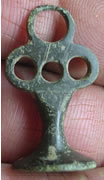 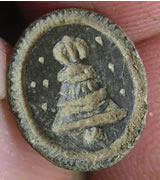 |
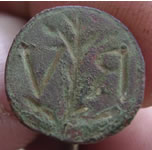 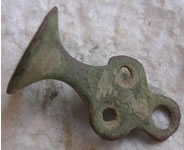 |
|||||||||||||||||||||
| 16th/17th seal matrix with Bell impression | 16thC Copper alloy Seal matrix 'RV' | |||||||||||||||||||||
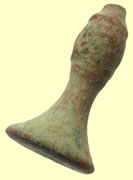 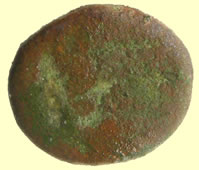 |
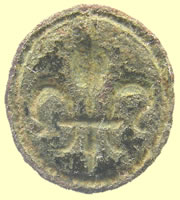 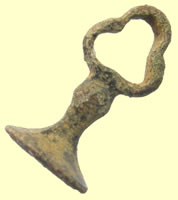 |
|||||||||||||||||||||
| 16thC Tudor seal spoon handle - AE | Late 16thC seal matrix with Fleur de Lis impression | |||||||||||||||||||||
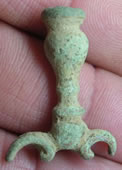 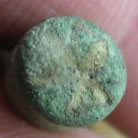 |
 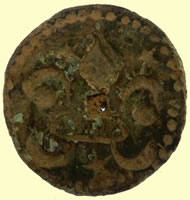 |
|||||||||||||||||||||
| 16thC seal matrix with flower design - very unusual type | 17thC seal matrix | |||||||||||||||||||||
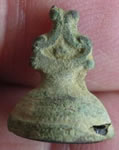 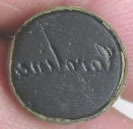 |
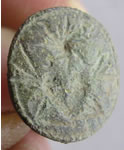 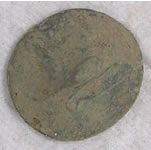 |
|||||||||||||||||||||
| 17thC Charles II fob seal - 'Carolius' | 17thC seal matrix | |||||||||||||||||||||
|
||||||||||||||||||||||
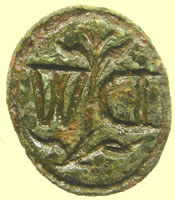 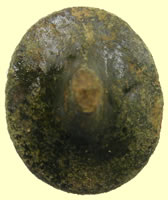 |
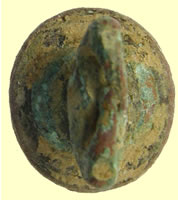 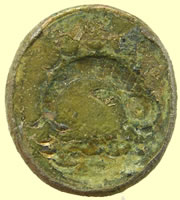 |
|||||||||||||||||||||
| 16th/17thC seal matrix - DW | Really nice 17thC seal matrix - fish jumping out of water impression | |||||||||||||||||||||
  |
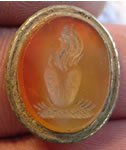 |
|||||||||||||||||||||
| 17thC seal matrix | 17thC Heart and flame intaglio seal | |||||||||||||||||||||
17thC seal Basically the seal has two Arabic words “khulqahu – subhanahu” which are attributes of God meaning something like “Allah, to whom be ascribed all perfection and majesty, as confirmed through His creation”
If I had to translate it using fewer words, I would say “Glory – His Creation”
17thC seal matrix
16thC seal matrix - DC
17thC seal matrix - heart and arrows inscription
17thC seal matrix
17th C seal matrix - griffin facing right impression
17th Seal matrix
17th Seal matrix
17th C silver seal matrix - reported as treasure to museum |
||||||||||||||||||||||
| Georgian seals | ||||||||||||||||||||||
Fob seal holders
The tiniest Georgian fob seal I have ever seen - you see the scale by the tweezers holding the seal - amazing skill to cut a detailed bust impression that small
|
||||||||||||||||||||||
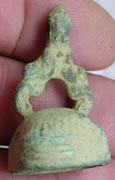 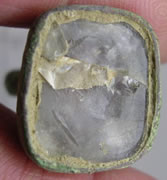 |
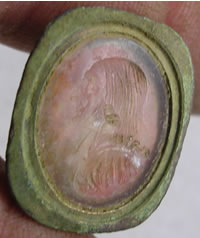  |
|||||||||||||||||||||
|
Georgian fob seal with head facing right impression
|
Georgian fob seal matrix with man looking left | |
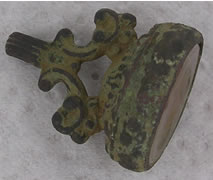 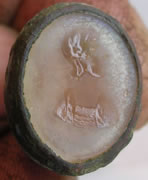 |
 |
|
| Fob seal matrix with woman facing right | Fob seal matrix with man facing right | |
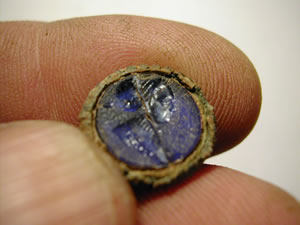 |
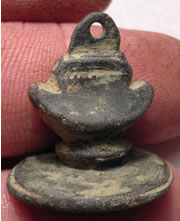 |
|
| Fob seal matrix with woman facing right | Uninscribed fob seal | |
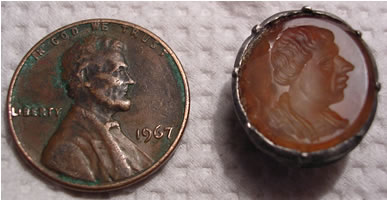 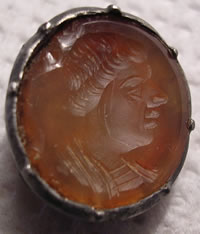 |
||
| Fantastic intaglio/seal- double faced as you change the light - man and woman | ||
 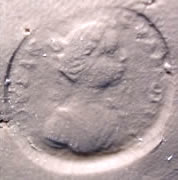 |
||
| Unusual bronze seal with full legend around the rim. Generally these are Georgian in date but further cleaning of the inscription should help with a better ID | ||
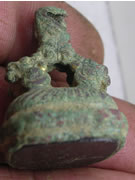 |
 |
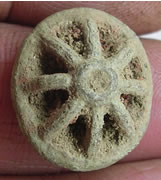 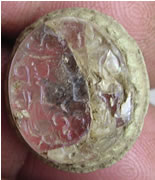 |
| Georgian fob seal with red stone | Georgian intaglio fob seal - rider on horse | 2 stag heads with Fleur De Lis on heraldic shield. The cartwheel back is not one I have seen before |
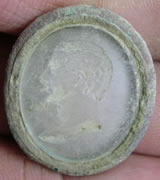 |
 |
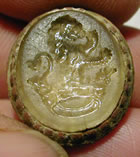 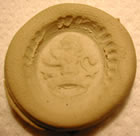 |
| Georgian fob seal intaglio | Georgian intaglio | seal matrix with lion and crown |
  |
 |
|
| Large Georgian desk seal matrix | Georgian fob seal with mans head facing right | |
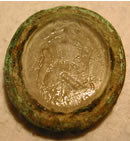 |
 |
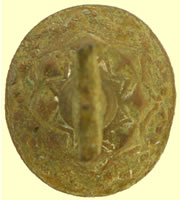 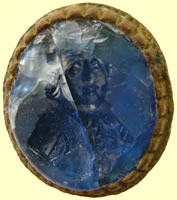 |
| 18thC Fob seal | Georgian fob seal -hogs head impression | Really neat Georgian glass fob seal - mans bust impression |
  |
  |
|
| Georgian fob seal | Neat Georgian seal matrix | |
   |
  |
|
| Georgian Naval fob seal - Man standing leaning left resting on anchor | Neat Georgian fob seal matrix | |
Georgian intaglio fob seal |
||
Georgian fob seal
Huge lead post medieval lead seal matrix 47mm dia, 81.54g Obv CHOO***V HAKENRICK & SON Rev CANT |
||
Georgian fob seal - VITE VITE Means Quickly quickly - Letter delivery stamp ?
Georgian silver seal matrix
Georgian seal ring pipe tamper with integral bowl cleaner
Georgian silver seal matrix
Huge Georgian fob seal
Georgian seal matrix - heart impression
Georgian fob seal - womans head facing right |
||
  |
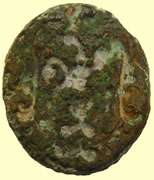   |
|
| Georgian fob seal | Georgian seal matrix | |
  |
 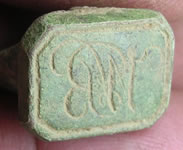 |
|
| Georgian intaglio brooch seal | Georgian seal matrix - unusual design probably had a wooden handle attached | |
Very neat Georgian triple sided seal matrix 'FORGET ME NOT'
Doubel sided Georgian fob seal matrix - needs cleaning |
||
Post medieval seal matrix, shows the word 'god speed' and what appears to be a plough underneath, neat relic. |
||
Double sided Georgian seal matrix
|
||
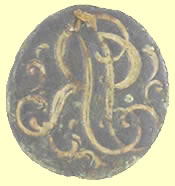 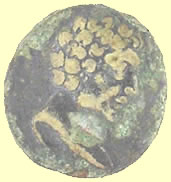 |
  |
|
| Mans head facing right, obv intials script 'JR' | Georgian silvered fob seal matrix - mans head facing right, obv intials script 'LK' |
|
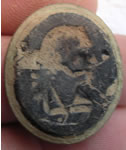 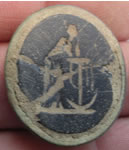 |
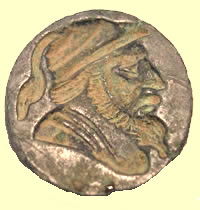 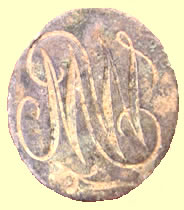 |
|
| Bust and anchor, probably belonged to a ships captain. | Bronze face with the initials MW on the reverse | |
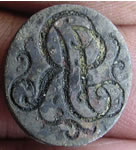 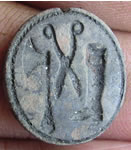 |
  |
|
| Georgian fob seal | Georgian double sided seal matrix | |
  |
  |
|
| Georgian double sided fob seal - Jewish profile head, Lion on reverse | Double sided Georgian fob seal matrix | |
  |
 |
|
| Georgian fob seal - Dove of peace flying right | Georgian seal matrix face | |
  |
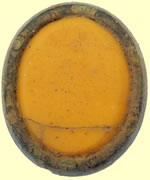  |
|
Georgian fob seal - hunting foxes 'Tally Ho' |
Georgian intaglio | |
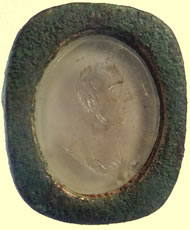  |
  |
|
| Georgian fob seal | Georgian silver plated seal matrix - needs cleaning to remove crust | |
 |
 |
 |
| Georgian fob seal | Georgian fob seal | Georgian fob seal matrix - lady standing leaning left on anchor |
 |
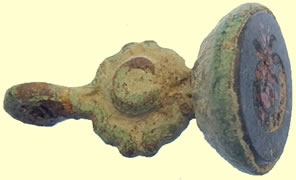 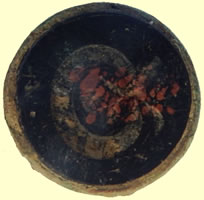 |
|
| Georgian fob seal | Georgian fob seal | |
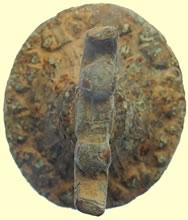 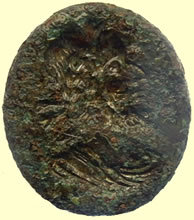 |
||
| 17thC seal matrix | ||
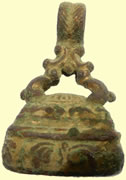 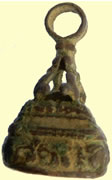 |
||
| Georgian fob seal holder | ||
Cracking silver seal picuture sent from the field
Georgian silver and stone seal matrix
Neat glass Georgian fob seal matrix
Double side Georgian seal matrix Obv Crest of Arms Rev Bust facing right
Double side Georgian seal matrix Obv Masted sailing ship facing right Rev Bust facing right
Georgian fob seal matrix
1794 silver seal matrix Maker CF - Crispin Fuller - registered Dec 1792 London duty paid symbol - date letter small t
Georgian fob seal matrix
Georgian fob seal - ship with oars facing left |
||
 |
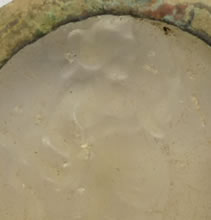 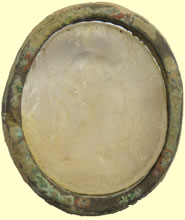 |
|
| Georgian fob seal - mans bust facing right | Georgian fob seal - lady standing facing right | |
  |
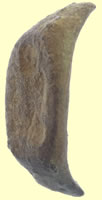 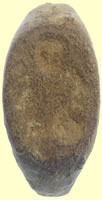 |
|
| Blank Georgian fob seal | Post medieval seal ring | |
Very neat relic - Georgian fob seal with watch winder attached |
||
Georgian fob seal - two eagle head impression |
||
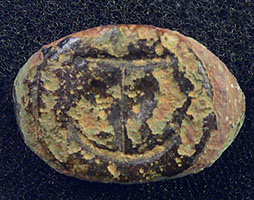 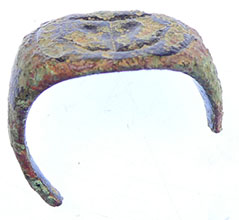 |
||
| Post medieval seal ring | ||
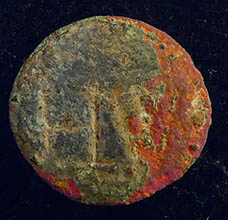   |
||
| 17thC seal matrix - HW | ||
Tiny Georgian silver fob seal matrix |
||
|
||
 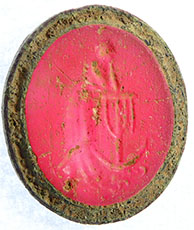 |
|
|
| Neat relic - Georgian double sided fob seal matrix | Georgian fob seal 'Alfred' |
|
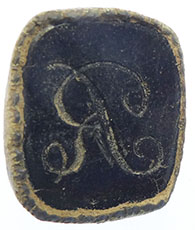 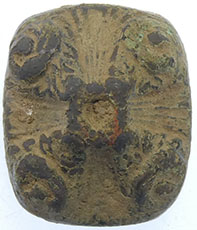 |
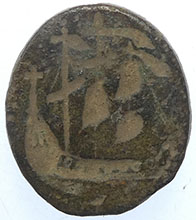 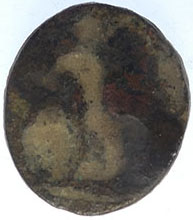 |
|
| Georgian fob seal - Letter R | Double sided Georgian fob seal | |
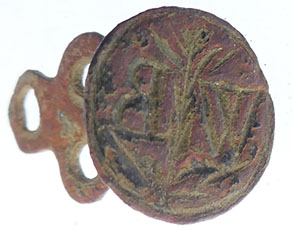 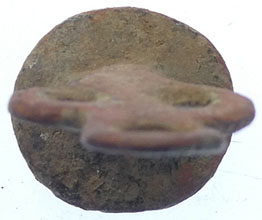 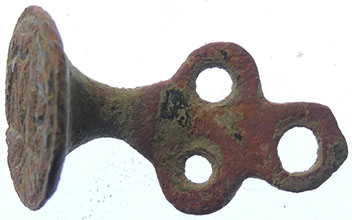 |
||
| 17thC seal matrix - WB | ||
Stunning Georgain fob seal |
||
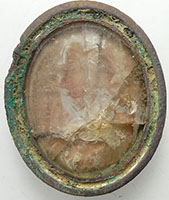 |
 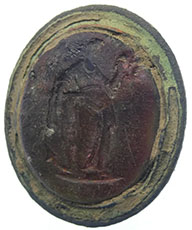 |
|
| Georgian intaglio | Georgian fob seal | |
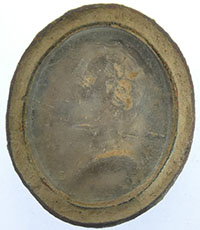  |
|
|
| Georgian fob seal - bust facing left | Georgian fob seal - horse and rider facing right | |
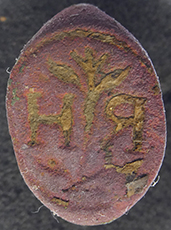 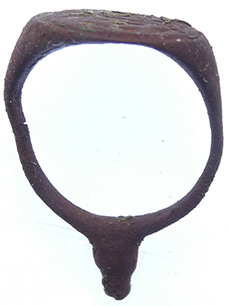 |
||
| 17th C seal ring - RH | ||
| Click here for Medieval seals page | ||
 |
||


